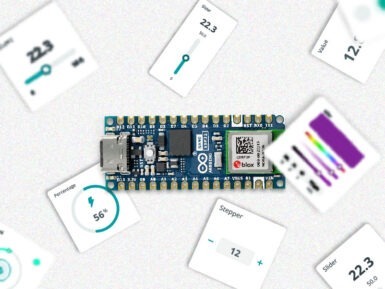
Arduino Nano Matter with headers
Sold outThe Arduino Nano Matter with headers stems from a partnership between Arduino and Silicon Labs® to make Matter®, one of the most popular IoT connectivity standards for smart home devices, accessible to all.
Overview
Nano Matter merges Arduino’s signature ease of use with with the powerful Silicon Labs® MGM240S, wrapping the best of two worlds into one of the smallest form factors currently on the market. Experimenting with Matter-compatible devices has never been easier!
With Nano Matter, makers – at all levels of expertise – can leverage the popular Matter IoT connectivity standard to build interactive solutions, upgrade previous Nano-based projects to fully function as smart home devices, and even experiment with protocols like Zigbee® and OpenThread.
Key benefits include:
- Matter-ready for quick prototyping, thanks to hardware support and a user-friendly software layer.
- Based on the MGM240SD22VNA from Silicon Labs, a 32-bit Arm® Cortex®-M33.
- Secure Vault™ technology: enjoy industry-leading, state-of-the art security from Silicon Labs against escalating IoT threats.
- Multiprotocol connectivity enables 802.15.4 (Thread) and Bluetooth® Low Energy
- Nano-family compact size and pinout.
- Debugging over USB via SWD interface: no external debugging probe needed!
- Low energy consumption, designed for battery powered IoT devices.
Need Help?
Check the Arduino Forum for questions about the Arduino Language or how to make your own Projects with Arduino. If you need any help with your product, please contact the official Arduino User Support through our Contact us page.
 The Matter Color Light will be the only officially Matter-certified profile for the Nano Matter. Currently under certification.
The Matter Color Light will be the only officially Matter-certified profile for the Nano Matter. Currently under certification.
Tech specs
| Microcontroller |
MGM240SD22VNA: 32-bit ARM Cortex®-M33 with DSP instruction and FPU |
Interfaces | I2C SPI UART PWM Digital I/Os ADC (up to 16 bit) DAC |
| Memory |
1536 kB Flash |
Security | Secure Vault® High |
| USB | 1x USB-C connector | Extra | RGB LED User push-buttons |
| Connectivity |
802.15.4 Thread® Bluetooth® Low Energy 5.3 and Bluetooth® Mesh Matter-ready Smart Home Connectivity |
I/O Voltage | 3.3V |
| Antenna | On-board 2.4GHz | Input Voltage (nominal) | 5V |
| Clock Speed | 78 MHZ | Dimensions | 18 mm x 45 mm |
Resources for Safety and Products
Manufacturer Information
The production information includes the address and related details of the product manufacturer.
Arduino S.r.l.
Via Andrea Appiani, 25
Monza, MB, IT, 20900
https://www.arduino.cc/
Responsible Person in the EU
An EU-based economic operator who ensures the product's compliance with the required regulations.
Arduino S.r.l.
Via Andrea Appiani, 25
Monza, MB, IT, 20900
Phone: +39 0113157477
Email: support@arduino.cc
Documentation
Learn more
Get Inspired
My project has a Nodemcu ESP8266 which is controlling a 7-segment display through the http server using html form.

… remote monitoring and control. 2. Embed a web server in the device Embedding a web server inside the IoT device allows you to visualize the data using a web browser. It requires the device to have network connectivity, and it is usually implemented connecting the device to a Wi-Fi access point or with the device creating its own WiFi hotspot. Although creating your own web server implementation can be done, one of the most widespread solutions is to make use of the library ESPAsyncWebServer. It allows your IoT device to serve custom HTML pages presenting the data. This is a very flexible and customizable solution, yet complex and mostly suitable for skilled users. There are plenty of insightful examples like the following ones: ESP32 Web Server - Arduino IDE | Random Nerd TutorialsArduino Project Hub - NodeMCU ESP8266 AJAX Enabled Web Server Arduino Project Hub - WiFi Robot Car / RC Car NodeMCU Web ServerESP32 Web Server: Display Sensor Readings in Gauges | Random Nerd Tutorials The scope of this solution is typically local — you need to be on the same network as the device — although with a more advanced configuration by enabling port forwarding in the router, the device could be accessed remotely from anywhere. One of the main advantages is its low latency, as the data shown in the web page comes directly from the device without any processing. On the other hand, it is a solution that requires a high programming skill level and additionally, due to the immutable nature of the firmware, every change in a dashboard requires code recompilation and firmware reflashing. Furthermore, embedding a web server or a Bluetooth stack within the device can be resource-intensive. This may limit the device's capabilities or require a more powerful microcontroller, increasing both cost and complexity. 3. Send data to an external system with plotting capabilities IoT devices can send data to external systems using different protocols, such as










